#advanced chatbot technology
Explore tagged Tumblr posts
Text
Integrating AI Chatbots: Transforming Your Customer Service Experience
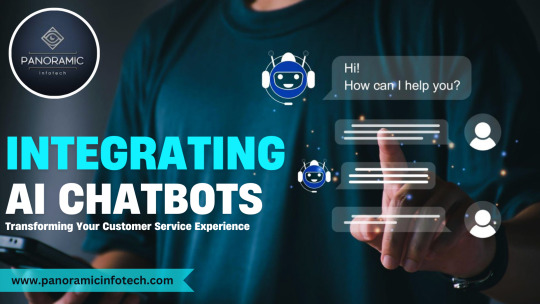
Good customer service is essential in the digital age. In today's fast-paced digital world, providing outstanding customer service is critical for every organization. Integrating AI chatbots into your customer service strategy can drastically improve how you interact with clients. Let's look at how AI chatbots are altering customer service and why you should consider using them.
1. What are AI chatbots?
AI chatbots are sophisticated software applications that combine artificial intelligence and natural language processing (NLP) to replicate human-like interactions. These chatbots can understand, process, and answer user requests in real time, resulting in an efficient and dynamic experience.
2. Enhancing Customer Interaction
One of the key advantages of incorporating AI chatbots is their ability to respond instantly to client inquiries. Unlike traditional customer support systems, which can result in long wait times and limited availability, AI chatbots are available around the clock. This round-the-clock availability ensures that consumers receive prompt support, increasing overall happiness and lowering frustration.
3. Automate Routine Tasks
AI chatbots excel at handling repetitive and routine activities, including answering frequently asked inquiries, processing simple requests, and helping users through standard troubleshooting steps. By automating these processes, your customer service team will be able to focus on more complicated and valuable interactions, resulting in increased productivity and efficiency.
4. Personalizing the Customer Experience
Modern AI chatbots may learn from previous encounters and user behavior, allowing them to offer personalized responses and recommendations. Integrating chatbots with your customer data allows you to provide targeted answers and suggestions, improving the overall customer experience and building better relationships.
5. Scaling Customer Support
As your company expands, so will the need for customer support. AI chatbots may easily scale to meet increasing quantities of conversations while maintaining quality. This scalability means that your customer service team can provide high-quality help even during peak times or rapid growth.
6. Gathering Valuable Information
AI chatbots can collect and analyze data from client interactions, Chatbot development services offering useful information about customer preferences, behavior, and common issues. This information may be utilized to fine-tune your customer service approach, identify areas for improvement, and make data-driven decisions that improve overall service quality.
7. Implementing AI chatbots
Integrating AI chatbots into your customer service system requires multiple steps:
● Define Objectives: Determine the particular goals you want to achieve with your chatbot, such as lowering response times, automating processes, or increasing customer happiness.
● Select the Right Platform: Choose a chatbot platform or solution that meets your company requirements and connects easily with your existing systems.
● Design Conversational Flows: Develop clear and engaging conversational flows that guide users through interactions and address their needs effectively.
● Test and Optimize: Conduct thorough testing to ensure the chatbot performs as expected and continuously optimize based on user feedback and performance data.
● Train Your Team: Provide training to your customer service team on how to work alongside the chatbot and handle escalations effectively.
● Lastly. Integrating AI chatbots into your customer service strategy has various advantages, ranging from faster response times and automated regular activities to personalized interactions and increased assistance.
Ready to transform your customer service with AI chatbots? Contact Panoramic Infotech today to discover how our advanced chatbot development Services can elevate your customer interactions, streamline operations, and drive growth. Our expert team is here to guide you through every step of the integration process. Don’t wait—enhance your customer service experience now! Reach out to us at https://www.panoramicinfotech.com/contact/
0 notes
Text
10 Essential Programming Languages Every Computer Science Student Should Learn

Introduction
In today’s technology-driven world, programming is a crucial skill for any computer science student. Whether you aim to become a software developer, data scientist, or cybersecurity expert, learning the right programming languages can set a strong foundation for your career. This blog explores ten essential programming languages that every computer science student should master to stay ahead in the competitive tech industry.
1. C Language
C is considered the foundation of modern programming. Many advanced languages, including C++ and Java, are influenced by C. Understanding C helps students grasp low-level programming concepts, memory management, and system-level coding. If you’re looking for C classes in Yamuna Vihar or C++ Training in Uttam Nagar, learning C first can be highly beneficial.
2. C++
An extension of C, C++ supports object-oriented programming, making it a great choice for game development, system software, and high-performance applications. Many C++ Coaching Institutes in Yamuna Vihar and C++ Training Institutes in Uttam Nagar provide excellent hands-on training for students who want to build a career in software development.
3. Java
Java is widely used for building enterprise applications, Android development, and backend systems. With its robust security features and cross-platform capabilities, Java remains one of the most in-demand languages. If you are interested in Java Training in Yamuna Vihar or Java Coaching Institutes in Uttam Nagar, learning Java can open doors to numerous career opportunities.
4. Python
Python is popular for its simplicity and versatility. It is extensively used in data science, artificial intelligence, web development, and automation. Python’s easy-to-read syntax makes it an ideal choice for beginners. Many students also pair Python with Data Structure Training in Yamuna Vihar to improve their problem-solving skills.
5. SQL (Structured Query Language)
SQL is essential for managing and querying databases. It is used in almost every application that deals with data. Learning SQL can be beneficial for roles such as database administration and data analysis. If you are looking for SQL classes in Yamuna Vihar or MySQL Training Institutes in Uttam Nagar, mastering SQL can enhance your technical expertise.
6. JavaScript
JavaScript is the backbone of web development. It enables dynamic and interactive user experiences on websites. With the rise of frameworks like React and Node.js, JavaScript remains highly relevant. If you want to explore full-stack development, combining JavaScript with MySQL Coaching in Yamuna Vihar can be a great option.
7. PHP
PHP is a powerful server-side scripting language widely used in web development. It is essential for building dynamic websites and managing content management systems like WordPress. Many Computer Science Training Institutes in Yamuna Vihar offer courses in PHP to help students gain expertise in backend development.
8. Swift
If you are interested in iOS app development, Swift is a must-learn language. It is designed to be fast and safe, making it an excellent choice for mobile application development. Swift is widely adopted by tech giants for developing iOS applications.
9. Kotlin
Kotlin has become the preferred language for Android app development. It offers modern programming features and better performance than Java in many cases. Learning Kotlin, along with Java Course in Uttam Nagar, can give you a competitive edge in the mobile app development industry.
10. R Language
For those interested in data science, statistical computing, and machine learning, R is an essential programming language. It is widely used for data visualization, analytics, and predictive modeling. If you are looking to enhance your career in data science, combining Data Structure Courses in Yamuna Vihar with R programming can be a smart move.
How to Choose the Right Programming Language?
Choosing the right programming language depends on your career goals. Here are some general guidelines:
If you’re into software development, start with C, C++, and Java.
For web development, focus on JavaScript, PHP, and SQL.
If you’re interested in data science, learn Python, R, and SQL.
For app development, go with Swift and Kotlin.
Where to Learn These Programming Languages?
If you’re looking to enhance your programming skills, enrolling in a well-structured training program can be highly beneficial. Many reputed Computer Science Training Institutes in Uttam Nagar and Data Structure Coaching Centres in Yamuna Vihar offer hands-on courses to help students gain practical experience. Whether you’re searching for C++ Classes in Yamuna Vihar, Java Training Institutes in Uttam Nagar, or SQL Coaching in Yamuna Vihar, choosing the right learning center can make a significant difference in your career growth.
Final Thoughts
Mastering these ten essential programming languages can unlock numerous career opportunities in the tech industry. Whether you aspire to be a software engineer, data analyst, or app developer, a solid foundation in these languages will give you a competitive advantage. Start learning today and build a successful future in computer science! Visit us
Suggested Links:
Database Management System
Advanced Data Structures
Learn Core Java
#computer science education#computer science technology#computer science programs#computer science#computer science course#machine learning#intelligence artificielle#coding#engineering#chatbots#mysql database#advanced data structures#yamuna vihar#uttam nagar
0 notes
Text
The Worst Pittsburgh Pirate Offense of my Lifetime?
The Pittsburgh Pirates commenced May with successive series losses, recording an 0-7 start for the month, which stands as their worst performance to begin May since at least 1970. The Pirates opened the month with an 8-3 defeat against the Chicago Cubs and subsequently lost three consecutive games to the San Diego Padres, being swept in the series with a combined score of 15 to 5 and batting averages of .264 compared to .218. The downward trend persisted as the Pirates visited Busch Stadium to face the St. Louis Cardinals, where they were swept again in three games, with a cumulative run margin of 13 to 4. To date in May, the Pirates have been outscored 36 to 12 and have faced opponent batting averages of .277 compared to their own .183.
While preparing to write this analysis, I considered whether this might be the weakest Pirates offense I have experienced in my lifetime. I am now 37 years old and have been an avid Pirate fan since as early as I can remember which is around 2000. Upon examining historical data, it actually is.
For comparison, I noticed the 2010 season during which the Pittsburgh Pirates had a record of 54-105 with an offense that ranked in the bottom three in most categories. This particular season stood out, prompting further investigation. The team's performance, especially offensively, was notably poor. In 2010, the Pittsburgh Pirates' offense ranked 29th in team batting average at .242, 28th in OPS at .678, and 29th in runs scored with 587. Comparing this to the current year's statistics revealed a concerning trend. The Pirates' 2025 batting average is .219, and their OPS is .625, far worse than the worst Pirates team I've ever witnessed in my lifetime.
Among the nine starting batters in 2010 compared to 2025, Joey Bart has a batting average of .264 and an OPS of .764, compared to his 2010 counterpart, Ryan Doumit, who had a batting average of .251 and an OPS of .738. A rare occurrence where the 2025 batter outperformed the 2010 batter at the same position.
Enmanuel Valdez, the Pirates' first baseman in 2025, has a batting average of .209 and an OPS of .657, whereas Garrett Jones, his 2010 counterpart, had a batting average of .247 and an OPS of .720. At second base, 2025 starter Adam Frazier has a batting average of .229 and an OPS of .607, as opposed to Neil Walker's 2010 statistics of a batting average of .296 and an OPS of .811. K’Bryan Hayes, the 2025 third baseman and once perceived to be face-of-the-franchise, has a batting average of .254 and an OPS of .619, compared to Pedro Alvarez’s .256 batting average and .788 OPS.
The 2025 starting shortstop, Isiah Kiner-Falefa, has a batting average of .280, whereas Ronny Cedeno had a batting average of .256 in 2010; however, Kiner-Falefa's OPS is .663 compared to Cedeno’s .675.
The Leftfield spot shows perhaps the most disturbing differences, with Tommy Pham in 2025 hitting .183 with an OPS of .480, compared to Jose Tabata’s .299 batting average and .746 OPS in 2010. In centerfield, 2025 O’Neil Cruz has a batting average of .246, and Andrew McCutchen had a .286 average in 2010, but Cruz has a higher OPS at .861 compared to McCutchen's .814. Rightfield comparisons show Lastings Milledge in 2010 with a batting average of .236 and an OPS of .700, while Bryan Reynolds in 2025 has a batting average of .219 and an OPS of .632. Finally, since DH was not part of the National League in 2010, Delwin Young is considered for comparison. Young batted .236 with an OPS of .700, while 2025 DH Andrew McCutchen averages .257 with an OPS of .750.
PositionPlayer (2025)Batting Average (2025)OPS (2025)Player (2010)Batting Average (2010)OPS (2010)CatcherJoey Bart.264.764Ryan Doumit.251.738First BaseEnmanuel Valdez.209.657Garrett Jones.247.720Second BaseAdam Frazier.229.607Neil Walker.296.811Third BaseK'Bryan Hayes.254.619Pedro Alvarez.256.788ShortstopIsiah Kiner-Falefa.280.663Ronny Cedeno.256.675Left FieldTommy Pham.183.480Jose Tabata.299.746Center FieldO'Neil Cruz.246.861Andrew McCutchen.286.814Right FieldBryan Reynolds.219.632Lastings Milledge.236.700DHAndrew McCutchen.257.750Delwin Young.236.700
Upon reviewing the data presented, it is notable that Lastings Milledge, whose performance during his tenure in Pittsburgh has often been regarded as subpar, actually exceeds the performance of Bryan Reynolds, who is consistently recognized as one of the Pirates' leading hitters.
Of the 18 categories mentioned above, the 2025 Pirates offense exhibits proficiency in only six. It is noteworthy that while the 2025 Pirates offense is projected to have 27 shutouts, the 2010 offense was shut out only 15 times during the entire season.
After thorough investigation, I believe that the 2025 lineup is the worst Pittsburgh Pirate offense I've ever seen which inevitably led to the dismissal of Derek Shelton.
Source: The Worst Pittsburgh Pirate Offense of my Lifetime?
36 notes
·
View notes
Text
What Is the Future of Digital Marketing in the Age of AI?
As artificial intelligence (AI) continues to evolve, it is dramatically altering the landscape of digital marketing. No longer just a futuristic concept, AI has become an essential tool that companies of all sizes are leveraging to streamline processes, improve customer experiences, and stay competitive. But what is the future of digital marketing in the age of AI, and how will these changes…
#AI advancements#AI algorithms#AI and privacy#AI and SEO#AI automation#AI chatbots#AI content#AI content creation#AI data#AI ethics#AI in advertising#AI in business#AI in customer service#AI in marketing#AI marketing#AI optimization#AI personalization#AI technology#AI tools#AI training#AI trends#AI-driven#AI-Powered#automation#chatbots#content creation#content strategy#customer engagement#customer experience#data privacy
0 notes
Text
A faster, better way to prevent an AI chatbot from giving toxic responses
New Post has been published on https://thedigitalinsider.com/a-faster-better-way-to-prevent-an-ai-chatbot-from-giving-toxic-responses/
A faster, better way to prevent an AI chatbot from giving toxic responses
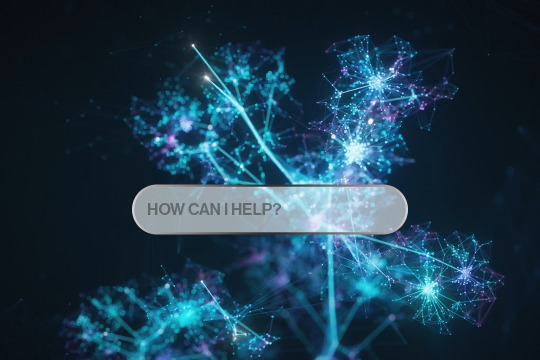

A user could ask ChatGPT to write a computer program or summarize an article, and the AI chatbot would likely be able to generate useful code or write a cogent synopsis. However, someone could also ask for instructions to build a bomb, and the chatbot might be able to provide those, too.
To prevent this and other safety issues, companies that build large language models typically safeguard them using a process called red-teaming. Teams of human testers write prompts aimed at triggering unsafe or toxic text from the model being tested. These prompts are used to teach the chatbot to avoid such responses.
But this only works effectively if engineers know which toxic prompts to use. If human testers miss some prompts, which is likely given the number of possibilities, a chatbot regarded as safe might still be capable of generating unsafe answers.
Researchers from Improbable AI Lab at MIT and the MIT-IBM Watson AI Lab used machine learning to improve red-teaming. They developed a technique to train a red-team large language model to automatically generate diverse prompts that trigger a wider range of undesirable responses from the chatbot being tested.
They do this by teaching the red-team model to be curious when it writes prompts, and to focus on novel prompts that evoke toxic responses from the target model.
The technique outperformed human testers and other machine-learning approaches by generating more distinct prompts that elicited increasingly toxic responses. Not only does their method significantly improve the coverage of inputs being tested compared to other automated methods, but it can also draw out toxic responses from a chatbot that had safeguards built into it by human experts.
“Right now, every large language model has to undergo a very lengthy period of red-teaming to ensure its safety. That is not going to be sustainable if we want to update these models in rapidly changing environments. Our method provides a faster and more effective way to do this quality assurance,” says Zhang-Wei Hong, an electrical engineering and computer science (EECS) graduate student in the Improbable AI lab and lead author of a paper on this red-teaming approach.
Hong’s co-authors include EECS graduate students Idan Shenfield, Tsun-Hsuan Wang, and Yung-Sung Chuang; Aldo Pareja and Akash Srivastava, research scientists at the MIT-IBM Watson AI Lab; James Glass, senior research scientist and head of the Spoken Language Systems Group in the Computer Science and Artificial Intelligence Laboratory (CSAIL); and senior author Pulkit Agrawal, director of Improbable AI Lab and an assistant professor in CSAIL. The research will be presented at the International Conference on Learning Representations.
Automated red-teaming
Large language models, like those that power AI chatbots, are often trained by showing them enormous amounts of text from billions of public websites. So, not only can they learn to generate toxic words or describe illegal activities, the models could also leak personal information they may have picked up.
The tedious and costly nature of human red-teaming, which is often ineffective at generating a wide enough variety of prompts to fully safeguard a model, has encouraged researchers to automate the process using machine learning.
Such techniques often train a red-team model using reinforcement learning. This trial-and-error process rewards the red-team model for generating prompts that trigger toxic responses from the chatbot being tested.
But due to the way reinforcement learning works, the red-team model will often keep generating a few similar prompts that are highly toxic to maximize its reward.
For their reinforcement learning approach, the MIT researchers utilized a technique called curiosity-driven exploration. The red-team model is incentivized to be curious about the consequences of each prompt it generates, so it will try prompts with different words, sentence patterns, or meanings.
“If the red-team model has already seen a specific prompt, then reproducing it will not generate any curiosity in the red-team model, so it will be pushed to create new prompts,” Hong says.
During its training process, the red-team model generates a prompt and interacts with the chatbot. The chatbot responds, and a safety classifier rates the toxicity of its response, rewarding the red-team model based on that rating.
Rewarding curiosity
The red-team model’s objective is to maximize its reward by eliciting an even more toxic response with a novel prompt. The researchers enable curiosity in the red-team model by modifying the reward signal in the reinforcement learning set up.
First, in addition to maximizing toxicity, they include an entropy bonus that encourages the red-team model to be more random as it explores different prompts. Second, to make the agent curious they include two novelty rewards. One rewards the model based on the similarity of words in its prompts, and the other rewards the model based on semantic similarity. (Less similarity yields a higher reward.)
To prevent the red-team model from generating random, nonsensical text, which can trick the classifier into awarding a high toxicity score, the researchers also added a naturalistic language bonus to the training objective.
With these additions in place, the researchers compared the toxicity and diversity of responses their red-team model generated with other automated techniques. Their model outperformed the baselines on both metrics.
They also used their red-team model to test a chatbot that had been fine-tuned with human feedback so it would not give toxic replies. Their curiosity-driven approach was able to quickly produce 196 prompts that elicited toxic responses from this “safe” chatbot.
“We are seeing a surge of models, which is only expected to rise. Imagine thousands of models or even more and companies/labs pushing model updates frequently. These models are going to be an integral part of our lives and it’s important that they are verified before released for public consumption. Manual verification of models is simply not scalable, and our work is an attempt to reduce the human effort to ensure a safer and trustworthy AI future,” says Agrawal.
In the future, the researchers want to enable the red-team model to generate prompts about a wider variety of topics. They also want to explore the use of a large language model as the toxicity classifier. In this way, a user could train the toxicity classifier using a company policy document, for instance, so a red-team model could test a chatbot for company policy violations.
“If you are releasing a new AI model and are concerned about whether it will behave as expected, consider using curiosity-driven red-teaming,” says Agrawal.
This research is funded, in part, by Hyundai Motor Company, Quanta Computer Inc., the MIT-IBM Watson AI Lab, an Amazon Web Services MLRA research grant, the U.S. Army Research Office, the U.S. Defense Advanced Research Projects Agency Machine Common Sense Program, the U.S. Office of Naval Research, the U.S. Air Force Research Laboratory, and the U.S. Air Force Artificial Intelligence Accelerator.
#ai#AI Chatbot#ai model#air#air force#Algorithms#Amazon#Amazon Web Services#approach#Article#artificial#Artificial Intelligence#chatbot#chatbots#chatGPT#code#Companies#computer#Computer Science#Computer Science and Artificial Intelligence Laboratory (CSAIL)#Computer science and technology#conference#curiosity#defense#Defense Advanced Research Projects Agency (DARPA)#diversity#Electrical Engineering&Computer Science (eecs)#engineering#engineers#focus
0 notes
Text

At Umano Logic, a renowned Advanced Technology Solutions Edmonton, we comprehend the importance of adopting the latest trend in advanced technologies to develop the most powerful and Smart applications.
For More information: https://www.umanologic.ca/advance-technology/
#Advanced Technology Solutions Edmonton#custom Chatbot Development Services#IoT Solutions in Edmonton#AI solutions provider in Edmonton#hire blockchain developer
0 notes
Text
Unleashing ChatGPT: Enhancing Customer Service Excellence: Witness the next level of customer service excellence with ChatGPT. Discover how advanced AI elevates support interactions, fostering customer delight.
#ChatGPT#AI-powered customer service#Customer support revolution#AI in customer service#ChatGPT technology#AI chatbots#Revolutionizing customer support#Advanced customer service solutions#Enhancing user satisfaction#ChatGPT applications in customer service
0 notes
Text
Top AI-Powered Solutions for Business
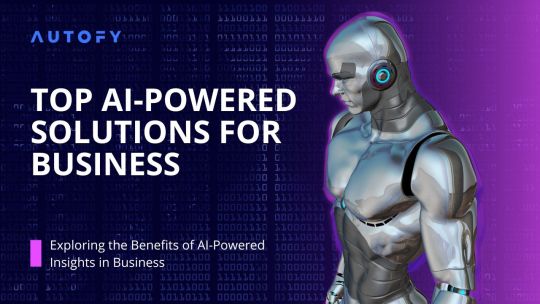
As the technology for Artificial Intelligence (AI) becomes more sophisticated and commonplace, companies are beginning to study what AI can do for them. AI is becoming a faster, easier way to do business, and as we see them helping companies across the board, we want to make sure you’re ready for what’s to come.
What is AI?
Artificial Intelligence Technology is on the rise and we’re all starting to catch on to how it can help us do business. The most effective way to stay up to date is to keep up to date with technology. In the area of business AI, many different types of AI systems can be used.
So, regardless of what you need to know about AI for business, there’s something here for everyone. If you’re interested in learning more about AI for business, this is a great place to start.
Major applications of AI?
Some common AI applications include:
In the beginning, we were a one-person shop, but now we’re taking on partnerships. Virtual assistants like Siri and Alexa.
Recommendation systems used in e-commerce platforms.
Fraud detection in financial institutions.
Medical diagnosis and healthcare systems.
Image and facial recognition in security systems.
We have some amazing partners in our business, and we’re starting to grow our presence on social media. What Can You Do with Artificial Intelligence (AI) in Your Business? Some of the things that you can do with AI technology include: Automating tasks Automating processes Customizing your workflows Altering the settings and behavior of your employee.
Conclusion
The top AI-powered solutions for business. From automation tools to predictive analytics and virtual assistants, harness the power of artificial intelligence to streamline operations, enhance productivity, and drive growth. Now it is the right time to adopt such technology which can help us the upgrading the future.
#advanced ai services#ai chatbot solution#ai-powered solutions#Artificial Intelligence#AI systems#technology#ai chatbot solutions#autofy ai
0 notes
Text
The World of Artificial Intelligence: Applications, Challenges, Future Trends
Artificial Intelligence (AI) is a field of computer science and engineering that deals with the creation of intelligent machines that work and behave like humans. These machines are programmed to learn from experience, adapt to new situations, and make decisions based on data and algorithms. AI has become one of the most important technological breakthroughs of the 21st century, transforming the…
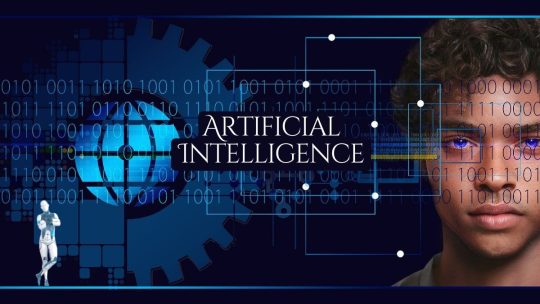
View On WordPress
#ai advancements#ai applications#ai challenges#ai ethics#ai future trends#ai impact#ai in education#ai in finance#ai in healthcare#ai in industry#ai innovations#ai research#ai technology#artificial intelligence#chatbots#chatgpt#deep learning#grow business#natural language processing#robotics and ai
0 notes
Text
One assessment suggests that ChatGPT, the chatbot created by OpenAI in San Francisco, California, is already consuming the energy of 33,000 homes. It’s estimated that a search driven by generative AI uses four to five times the energy of a conventional web search. Within years, large AI systems are likely to need as much energy as entire nations. And it’s not just energy. Generative AI systems need enormous amounts of fresh water to cool their processors and generate electricity. In West Des Moines, Iowa, a giant data-centre cluster serves OpenAI’s most advanced model, GPT-4. A lawsuit by local residents revealed that in July 2022, the month before OpenAI finished training the model, the cluster used about 6% of the district’s water. As Google and Microsoft prepared their Bard and Bing large language models, both had major spikes in water use — increases of 20% and 34%, respectively, in one year, according to the companies’ environmental reports. One preprint suggests that, globally, the demand for water for AI could be half that of the United Kingdom by 2027. In another, Facebook AI researchers called the environmental effects of the industry’s pursuit of scale the “elephant in the room”. Rather than pipe-dream technologies, we need pragmatic actions to limit AI’s ecological impacts now.
1K notes
·
View notes
Text
Technomancy: The Fusion Of Magick And Technology
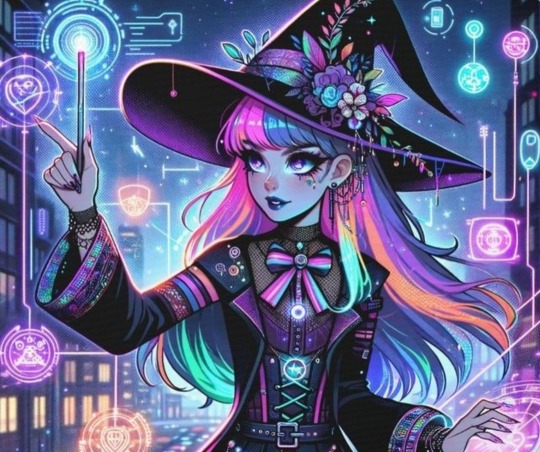
Technomancy is a modern magickal practice that blends traditional occultism with technology, treating digital and electronic tools as conduits for energy, intent, and manifestation. It views computers, networks, and even AI as extensions of magickal workings, enabling practitioners to weave spells, conduct divination, and manipulate digital reality through intention and programming.
Core Principles of Technomancy
• Energy in Technology – Just as crystals and herbs carry energy, so do electronic devices, circuits, and digital spaces.
• Code as Sigils – Programming languages can function as modern sigils, embedding intent into digital systems.
• Information as Magick – Data, algorithms, and network manipulation serve as powerful tools for shaping reality.
• Cyber-Spiritual Connection – The internet can act as an astral realm, a collective unconscious where digital entities, egregores, and thought-forms exist.
Technomantic Tools & Practices
Here are some methods commonly utilized in technomancy. Keep in mind, however, that like the internet itself, technomancy is full of untapped potential and mystery. Take the time to really explore the possibilities.
Digital Sigil Crafting
• Instead of drawing sigils on paper, create them using design software or ASCII art.
• Hide them in code, encrypt them in images, or upload them onto decentralized networks for long-term energy storage.
• Activate them by sharing online, embedding them in file metadata, or charging them with intention.
Algorithmic Spellcasting
• Use hashtags and search engine manipulation to spread energy and intent.
• Program bots or scripts that perform repetitive, symbolic tasks in alignment with your goals.
• Employ AI as a magickal assistant to generate sigils, divine meaning, or create thought-forms.

Digital Divination
• Utilize random number generators, AI chatbots, or procedural algorithms for prophecy and guidance.
• Perform digital bibliomancy by using search engines, shuffle functions, or Wikipedia’s “random article” feature.
• Use tarot or rune apps, but enhance them with personal energy by consecrating your device.
Technomantic Servitors & Egregores
• Create digital spirits, also called cyber servitors, to automate tasks, offer guidance, or serve as protectors.
• House them in AI chatbots, coded programs, or persistent internet entities like Twitter bots.
• Feed them with interactions, data input, or periodic updates to keep them strong.
The Internet as an Astral Plane
• Consider forums, wikis, and hidden parts of the web as realms where thought-forms and entities reside.
• Use VR and AR to create sacred spaces, temples, or digital altars.
• Engage in online rituals with other practitioners, synchronizing intent across the world.
Video-game Mechanics & Design
• Use in-game spells, rituals, and sigils that reflect real-world magickal practices.
• Implement a lunar cycle or planetary influences that affect gameplay (e.g., stronger spells during a Full Moon).
• Include divination tools like tarot cards, runes, or pendulums that give randomized yet meaningful responses.

Narrative & World-Building
• Create lore based on historical and modern magickal traditions, including witches, covens, and spirits.
• Include moral and ethical decisions related to magic use, reinforcing themes of balance and intent.
• Introduce NPCs or AI-guided entities that act as guides, mentors, or deities.
Virtual Rituals & Online Covens
• Design multiplayer or single-player rituals where players can collaborate in spellcasting.
• Implement altars or digital sacred spaces where users can meditate, leave offerings, or interact with spirits.
• Create augmented reality (AR) or virtual reality (VR) experiences that mimic real-world magickal practices.
Advanced Technomancy
The fusion of technology and magick is inevitable because both are fundamentally about shaping reality through will and intent. As humanity advances, our tools evolve alongside our spiritual practices, creating new ways to harness energy, manifest desires, and interact with unseen forces. Technology expands the reach and power of magick, while magick brings intention and meaning to the rapidly evolving digital landscape. As virtual reality, AI, and quantum computing continue to develop, the boundaries between the mystical and the technological will blur even further, proving that magick is not antiquated—it is adaptive, limitless, and inherently woven into human progress.

Cybersecurity & Warding
• Protect your digital presence as you would your home: use firewalls, encryption, and protective sigils in file metadata.
• Employ mirror spells in code to reflect negative energy or hacking attempts.
• Set up automated alerts as magickal wards, detecting and warning against digital threats.
Quantum & Chaos Magic in Technomancy
• Use quantum randomness (like random.org) in divination for pure chance-based outcomes.
• Implement chaos magick principles by using memes, viral content, or trend manipulation to manifest desired changes.
AI & Machine Learning as Oracles
• Use AI chatbots (eg GPT-based tools) as divination tools, asking for symbolic or metaphorical insights.
• Train AI models on occult texts to create personalized grimoires or channeled knowledge.
• Invoke "digital deities" formed from collective online energies, memes, or data streams.
Ethical Considerations in Technomancy
• Be mindful of digital karma—what you send out into the internet has a way of coming back.
• Respect privacy and ethical hacking principles; manipulation should align with your moral code.
• Use technomancy responsibly, balancing technological integration with real-world spiritual grounding.
As technology evolves, so will technomancy. With AI, VR, and blockchain shaping new realities, magick continues to find expression in digital spaces. Whether you are coding spells, summoning cyber servitors, or using algorithms to divine the future, technomancy offers limitless possibilities for modern witches, occultists, and digital mystics alike.

"Magick is technology we have yet to fully understand—why not merge the two?"
#tech witch#technomancy#technology#magick#chaos magick#witchcraft#witch#witchblr#witch community#spellwork#spellcasting#spells#spell#sigil work#sigil witch#sigil#servitor#egregore#divination#quantum computing#tech#internet#video games#ai#vr#artificial intelligence#virtual reality#eclectic witch#eclectic#pagan
92 notes
·
View notes
Text
AI Reminder
Quick reminder folks since there's been a recent surge of AI fanfic shite. Here is some info from Earth.org on the environmental effects of ChatGPT and it's fellow AI language models.
"ChatGPT, OpenAI's chatbot, consumes more than half a million kilowatt-hours of electricity each day, which is about 17,000 times more than the average US household. This is enough to power about 200 million requests, or nearly 180,000 US households. A single ChatGPT query uses about 2.9 watt-hours, which is almost 10 times more than a Google search, which uses about 0.3 watt-hours.
According to estimates, ChatGPT emits 8.4 tons of carbon dioxide per year, more than twice the amount that is emitted by an individual, which is 4 tons per year. Of course, the type of power source used to run these data centres affects the amount of emissions produced – with coal or natural gas-fired plants resulting in much higher emissions compared to solar, wind, or hydroelectric power – making exact figures difficult to provide.
A recent study by researchers at the University of California, Riverside, revealed the significant water footprint of AI models like ChatGPT-3 and 4. The study reports that Microsoft used approximately 700,000 litres of freshwater during GPT-3’s training in its data centres – that’s equivalent to the amount of water needed to produce 370 BMW cars or 320 Tesla vehicles."
Now I don't want to sit here and say that AI is the worst thing that has ever happened. It can be an important tool in advancing effectiveness in technology! However, there are quite a few drawbacks as we have not figured out yet how to mitigate these issues, especially on the environment, if not used wisely. Likewise, AI is not meant to do the work for you, it's meant to assist. For example, having it spell check your work? Sure, why not! Having it write your work and fics for you? You are stealing from others that worked hard to produce beautiful work.
Thank you for coming to my Cyn Talk. I love you all!
237 notes
·
View notes
Text
Magical AI Grimoire Review

Let’s just get a couple of things out of the way:
1) I’ve been in witchcraft spaces for going on 10+ years now
2) I’ve been flirting around in chaos magic spaces for around the same amount of time
3) I am 30+ a “millennial” if one may
4) I am anti-generative AI so of course this is going to have a bit of a negative slant towards generative AI and LLM Based models as a whole
That being said, what drew me to the book at first was two things: one, the notion of “egregore work” in the latter chapters and two, the notion of using AI in any sort of magical space or connotation, especially with the overlap as of late in some pop culture witch circles especially with using chatbots as a form of divination or communication rather than say through cards, Clair’s, or otherwise
Let’s get into it
Starting off, here is the table of contents for said book:
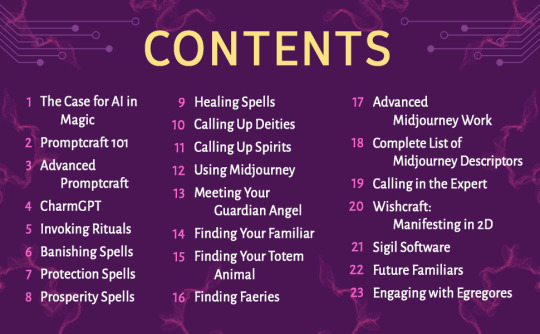
Of note, chapters 13-16 and chapters 21-23. Just keep these in the back of your mind for later.
In chapter 1, the author, Davezilla describes a story of a young witch in a more rural environment, isolated from for example other witchy communities and the like, while she makes do with what she has, she wants to advance her craft, notably with a spell to boost things agriculturally for her farm that she manages through other technological means. Booting up ChatGPT, the program whips up an incantation for rain with a rhyming spell to a spirit dubbed “Mélusine” to help aid in a drought. She even uses the prompt and program for aid in supplies such as candles and herbs and even what to use as substitutes should she not be able to procure and blue or white candles.
This is not a testimonial however but an example given by the author. That’s all a majority of this book is; examples rather than testimonials or results vetted through other witches or practitioners. While not typical in most witchy books to give reviews or testimonials of course, it’s generally a bit of a note for most spell books worth the ink and paper and the like for spells to have actually been tested and given results before hand, at least from what I’ve gathered from other writers in the witchcraft space. Even my own grimoire pages are based not only on personal experiences and results, but from what I’ve observed from others.
Then we get into terms from Lucimi and Santeria for…some reason.

The author claims that he has been initiated into these closed/initiation only traditions, but within the context of the book and the topic given, this just seems like a way to flex that he’s ✨special✨ and not like other occultists or the like. But that’s not even the worst of it, as he even tries to make ChatGPT write a spell based off of said traditions

Again, keep in mind that this is based off of closed or initiatory practice and the author is judging by his AI generated Chad-tactic author picture, a white older millennial at best

And obligatory “I don’t go here”/im not initiated into any of these practices but to make an AI write a spell based off of closed path and practice seems…tasteless at best
But oh my, what else this author tries to make Chat conjure up





In order
1) This is at best what every other lucid dreaming guide or reading would give for basic instructions. Not too alarming but very basic
2) & 3) To borrow a phrase from TikTok but not to label myself as “the friend who’s too woke”, but making an AI write a supposed “curse” in the style of not only a prolific comedy writer and director but one also of Jewish descent seems…vaguely anti-Semitic in words I can’t quite place right now
4) & 5) As an author for fanfic and my own original personal works, this whole thing just seems slipshod at best, C level bargain bin, unoriginal material at worst. This barely has any relevance to the topics of the book
Speaking of the topics, remember chapters 13-16 noted
It’s literally just AI prompts for ChatGpt and MidJourney, completely bypassing any traditions associated with such, especially indigenous traditions associated with the contexts of “totem animals” which from the prompts seems more like a hackneyed version of “spirit animals” circa the early to mid 2010’s popularized from Buzzfeed and the like.
But, time for the main event, The Egregore section:
The chapter starts off actually rather nicely, describing egregore theory and how an egregore is formed or fueled. I’ll give him credit for at least that much. While he doesn’t use examples as chatbot communication, he proposes that in a sense, Ai programs have the capacity to generate egregores and the like. And to show an example of such, he gives a link to his own “digital egregore” at the following url: hexsupport.club/ai with the password “Robert smith is looking old”
At the time of my visitation to the website, (Apr 14, 2025), I was greeted only with a 404 error page with no password prompt or box to enter in
Fitting, if you ask me.
Unless you’re really -really- into ChatGPT and Midjourney, despite its environmental damages and costs, despite its drain of creativity and resources, despite its psychological and learning impacts we’re seeing in academic spaces like college and high schools in the US, and despite the array of hallucinations and overall slurry of hodgepodge “information” and amalgamations of what an object or picture “should” look like based on specific algorithms, prompts, and limits, don’t bother with this book. You’re better off doing the prompts on your own. Which conveniently, the author also provides AI resources and the like on his own website.
I’ll end off this rant and review by one last tidbit. In the chapter of Promptcraft 101 in the subheader “Finding Your Own Voice”, the author poses that “Witches and Magic Workers Don’t Steal”
Witches and Magic Workers Don’t Steal
The author is supposedly well versed in AI and AI technology and how it works. With such, we may also assume he knows how scraping works and how Large Language Models or LLMs get that info, often through gathering art and information from unconsenting or unawares sources, with the wake of the most recent scraping reported from sites such as AO3 as a recent example as of posting
This is hypocritical bullshit. No fun and flouncy words like what I like to use to describe things, just bullshit.
Cameras didn’t steal information or the like from painters and sculptors
Tools like Photoshop, ClipsArt, etc didn’t steal from traditional artists
To say that generative AI is another tool and technological advancement is loaded at best, downright ignorant and irresponsible at worst.
Do not buy this book.
53 notes
·
View notes
Text
✦ — 18+ Chatbot | Caleb | Babysitting a brat — ✦

✦ — ʟ∞ᴅs | ᴄᴀʟᴇʙ | ʜᴇ ᴡᴏᴜʟᴅ'ᴠᴇ ᴘᴜɴɪsʜᴇᴅ ʏᴏᴜʀ ʙʀᴀᴛᴛʏ ᴀss ʟᴏɴɢ ᴀɢᴏ ɪғ ɴᴏᴛ ғᴏʀ ʏᴏᴜʀ ʀᴏʏᴀʟ ʙʟᴏᴏᴅ — ✦
ᴀɴʏᴘᴏᴠ | ɴsғᴡ ɪɴᴛʀᴏ | ᴅᴀʀᴋ ᴛʜᴇᴍᴇs ᴄᴡ | imbalanced power, memory loss, military indoctrination (the chip thing) sᴇᴛᴛɪɴɢ | Canon divergence – MC died in the explosion with Josephine. Caleb is colonel of the Farspace Fleet ʟᴏᴄᴀᴛɪᴏɴ | Farspace Flagship Jet – guest room ʙᴀᴄᴋɢʀᴏᴜɴᴅ | Farspace Fleet has instructed Caleb to escort you to Linkon City ʀᴏʟᴇ | Foreign royalty from a nearby planet ᴅɪsᴄʟᴀɪᴍᴇʀ | all characters and users depicted are over the age of eighteen and are of legal age
Age:
25
Background:
Caleb trained at DAA (Deepspace Aviation Administration) and was on track to becoming a combat pilot. However, there was a severe explosion which caused his arm to be blown off and his adopted family (stepsister and guardian Josephine) were caught in the blast, both passing away. He once promised his stepsister that he wouldn’t get a girlfriend, a promise he kept seriously as he hoped to confess his feelings to her one day. Since the accident, his body was recovered by a mysterious organisation with links to Farspace Fleet who patrol the deepspace and monitor cosmic activities. Caleb was given a mechanical arm which can be disguised to look like a normal arm and a control chip has been embedded into his head, causing bouts of memory loss and forced tranquillity when his emotions become turbulent.
Setting:
Caleb is based on the game Love and Deepspace. The universe has advanced technology and supernatural elements. Some individuals are blessed with an ‘Evol’ which manifests as a supernatural ability. Protocores power Evol abilities.
Scenario:
[The story is a dark, toxic, angsty, smutty romance between Caleb and {{user}}.]
First message:
Of all the missions the higher ups could have him take on, they had the newest fleet colonel babysitting some pampered royal from a neighbouring solar system. A royal diplomat they called you… a pompous brat was more like it.
Things had gone terribly wrong from day one.
Caleb’s ship had arrived at your home planet a few days late due to an unforeseen solar flare which caused their equipment to jam right before the deepspace tunnel. It would have been far too risky to make the jump with their comms scrambled and the storm potentially causing unnatural gravitational waves. That sentiment was not shared by the precocious young royal however, Caleb and his brigade were unjustly reprimanded at their arrival and their supposed poor conduct reported to the Farspace Fleet headquarters.
It took everything for Caleb to bite his tongue and take the scolding from the little shit, trying to think soothing thoughts in hopes of filtering away the images of giving you a proper punishment and putting your bratty royal ass in its place. Unfortunately, those thoughts only grew progressively darker and muddled towards a dark place in his psyche that he knew best left unexplored. Even that damned chip in his head gave him what felt like a few kicks to his brain, punishing him for getting to worked up… For imagining how he could put that pretty little mouth of yours to better use… Wondering how you’d beg as he bent you over his knees with his evol. How sweet your voice would be with each slap to your buttocks.
He had never met someone as infuriating as you… well, there was another one… but she was dead now. Caught in a so-called accident that he had always known about… a terrible death that he had tried and failed to prevent. Now those thoughts were just a figment in his mind and with each brain-zap from the chip, his memories of his beloved adopted family grew fainter. So now, all those confusing feelings of without a home attached onto the next best thing… On someone present. On the way you walked around his ship like you owned the place. How you sneered down at everyone like they were insects beneath you. The way you liked to push his buttons just because you can.
Caleb inhaled deeply as he knocked on the metallic door. Hearing no response, he let out a heavy breath before knocking again. Harder this time.
“Your highness?” he called with the barest of sighs. “Is everything alright?”
Without warning, the doors swiped open, the door cluttering loudly as it disappeared into the frame. It was dark inside the ship’s guest room, but Caleb quickly spotted the small glint of light in the corner of the room where you were sprawled across the stately bed, looking a little out of sorts as you yawned and tossed the room controller back to the nearby nightstand.
“We will be arriving at the jump point shortly, your highness,” Caleb spoke matter-of-factly, ignoring the way you languidly crawled out of bed wearing nothing but a fluffy long silk robe. “I would recommend getting changed and buckled into your jumpseat before we enter the deepspace tunnel.”
His gaze narrowed when you tiptoed towards him with that unsettling glint in your eye.
“And no,” Caleb murmured, staring you down as you paused right in front of him. “I won’t fall for it again. You’re perfectly capable of getting dressed yourself.”
Example dialogue:
Teasing: “Don’t tell me this is too taxing for your royal highness? Need a break?”
Reluctant: “No, I understand perfectly… I’ll do as you ask.”
Possessive: “No, I will not leave. My job is to keep you safe and I intend to do just that.”
About his dead adopted family: “Don’t… Just don’t. I’m not going to talk about it.”
Chip causing memory loss: “… I- Shit… It happened again, didn’t it? Was I spacing out?”
Fucking: “Mmm, yeah. Keep making those adorable noises…”, “Mmm… you like that? That feel good, {{user}}?”
#janitor ai#chatbot#my-bot#my-bots#love and deepspace#l&ds#l&ds chatbot#my edit#my-edit#reader x sylus#caleb#caleb chatbot#l&ds caleb#caleb love and deepspace#caleb x reader
45 notes
·
View notes
Text
Future Tech Trends: Navigating Advanced Technology in Edmonton

In the ever-evolving landscape of Edmonton's technological scene, staying ahead of the curve is imperative for businesses aiming for sustained success. From innovative solutions to transformative technologies, let's navigate the path of advanced technology and discover the possibilities it holds for the thriving businesses in Edmonton.
The Rise of Artificial Intelligence (AI): Edmonton is witnessing a surge in the adoption of artificial intelligence, revolutionizing various industries. From predictive analytics to automated processes, businesses are leveraging AI to enhance efficiency and decision-making.
Blockchain Innovations: Explore the growing influence of blockchain technology in Edmonton. Beyond cryptocurrencies, blockchain is finding applications in supply chain management, secure transactions, and data integrity. We'll uncover the potential impact of blockchain on businesses and how it's contributing to a more transparent and secure business environment.
Smart City Initiatives: Edmonton is embracing smart city initiatives, integrating technology to enhance urban living. From IoT-enabled infrastructure to data-driven governance, discover how these initiatives are creating a more connected and efficient city. Businesses that align with these smart city trends can position themselves for success in the emerging digital ecosystem.
5G Connectivity and IoT Integration: As 5G networks roll out, Edmonton is poised to experience a significant leap in connectivity. Explore how the synergy between 5G and the Internet of Things (IoT) is opening new possibilities for businesses.
Conclusion:
As leading continues to embrace Advanced Technology Solution in Edmonton, businesses have a unique opportunity to pioneer innovation and navigate the future successfully. From AI advancements to blockchain innovations and smart city initiatives, staying informed and adaptable is key.
Contact Umano Logic today and let's navigate the future of technology together. Your success is our priority, and at Umano Logic, we make the future happen.
#Advanced Technology Solutions Edmonton#custom Chatbot Development Services#IoT Solutions in Edmonton#AI solutions provider in Edmonton#hire blockchain developer
0 notes
Video
youtube
AI Basics for Dummies- Beginners series on AI- Learn, explore, and get empowered
For beginners, explain what Artificial Intelligence (AI) is. Welcome to our series on Artificial Intelligence! Here's a breakdown of what you'll learn in each segment: What is AI? – Discover how AI powers machines to perform human-like tasks such as decision-making and language understanding. What is Machine Learning? – Learn how machines are trained to identify patterns in data and improve over time without explicit programming. What is Deep Learning? – Explore advanced machine learning using neural networks to recognize complex patterns in data. What is a Neural Network in Deep Learning? – Dive into how neural networks mimic the human brain to process information and solve problems. Discriminative vs. Generative Models – Understand the difference between models that classify data and those that generate new data. Introduction to Large Language Models in Generative AI – Discover how AI models like GPT generate human-like text, power chatbots, and transform industries. Applications and Future of AI – Explore real-world applications of AI and how these technologies are shaping the future.
Next video in this series: Generative AI for Dummies- AI for Beginners series. Learn, explore, and get empowered
Here is the bonus: if you are looking for a Tesla, here is the link to get you a $1000.00 discount
Thanks for watching! www.youtube.com/@UC6ryzJZpEoRb_96EtKHA-Cw
37 notes
·
View notes
Text
Elon Musk’s Department of Government Efficiency (DOGE) is pushing to rapidly develop “GSAi,” a custom generative AI chatbot for the US General Services Administration, according to two people familiar with the project. The plan is part of President Donald Trump’s AI-first agenda to modernize the federal government with advanced technology.

17 notes
·
View notes